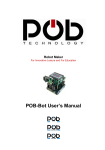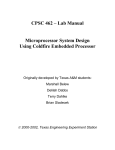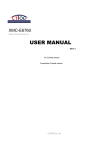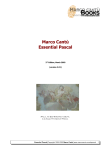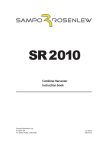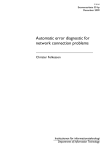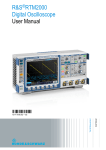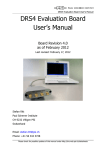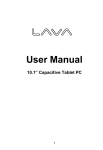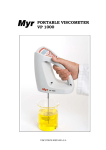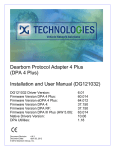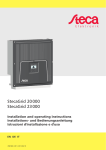Download DPAS.DOC - OoCities
Transcript
Dieter R. Pawelczak
DPas32 - 32 bit Pascal Compiler
The DPas User Manual & Reference Guide
Dieter R. Pawelczak
(C) 1997-2000 by Dipl.-Ing. (Univ) Dieter R. Pawelczak,
Fasanenweg 41,
D-85540 Haar,
Germany
All rights reserved. This manual is sold subject to the condition that it shall not, by the way
of trade or otherwise, be lent, re-sold, hired out or otherwise circulated without the prior
written permission of the author.
No part of this publication may be reproduced or transmitted in any form or by any means,
electronically, optical or mechanically, including photocopying, recording or any information
storage or retrieval system without either the prior written permission of the author or a
license from the author, permitting restricted copying.
The author takes no warranty for the examples, the manuals, the usage and the code
generation of DPas32. The software comes without any warranty.
Windows, MS-DOS is a trademark of Microsoft, Pentium is a trademark of Intel.
Turbo Pascal (TP) is a trademark of Borland Inc., now Inprise.
For my dear wife Alexandra
4
About
This is the first BETA release of the DPas Compiler. The difference between the previous
ALPHA releases is huge, especially concerning the code generation and optimization.
DPas is a Pascal Compiler, that generates directly executable 32-bit Applications without any
further Assembling or Linking.
The Compiler structure is a direct code generator, i.e. there are no stages between parsing,
scanning and code generation. This makes the source code of the compiler on the one hand
very tough, on the other hand, it provides a lot of advantages. The main advantage was, that
even with only a very little functionality, the compiler already created executable code.
That’s, why I already published a preliminary Alpha Version in 1997! This release was just
able to understand integer expressions and most standard Pascal commands with a lot of
limitations. Nevertheless, with a bit luck, I managed to code the Pro 32 debugger already with
this initial release.
Another advantages is, that the compiler requires a minimum of heap memory. Without
building a real command tree, the compiler saves a lot of memory. As DPas is a DOS
product, written with Turbo Pascal, this is very important. The compiler needs only memory
to store the symbol names. So any source is only limited by the number of symbols.
And last but not least, the compiler is very fast. Again for the same reasons. During the
parsing of the source, the compiler already creates code.
In the mean time, the compiler creates highly optimized code. This makes the compiler source
code very complex, as each optimization depends on previous read code and following code.
Especially hard is, of course, the error tracing. As for each optimization a corresponding test
program needs to be written, this is an immense effort. Therefore, DPas will remain for quite
some time a BETA version.
DPas is an ongoing development. In brief, this is planned for the near future:
– Win32 support
– DPas is able to compiler Pass32
– DPas is able to compile itself
5
Contents
About ................................................................................................................................4
Contents ............................................................................................................................5
Introduction ......................................................................................................................7
1. Getting Started with DPas ................................................................... 9
1.1
1.2
1.2.1
1.2.2
1.3
1.4
1.4.1
1.4.2
1.5
1.5.1
1.5.2
First Example ........................................................................................................9
Compiling with DPas32......................................................................................10
Compiling Programs and Units ...........................................................................10
Compiling the SYSTEM Unit .............................................................................11
The Command Line Arguments .........................................................................12
The Standard Program Structure ........................................................................12
Structure of the Source Code ..............................................................................12
Structure of the Program Code............................................................................14
The Compiler Directives.....................................................................................15
Compiler Control Directives ...............................................................................16
Code Generator Control Directives.....................................................................17
2. The DPas Language............................................................................ 19
2.1
2.1.1
2.1.2
2.1.3
2.1.4
2.1.5
2.1.6
2.2
2.3
2.4
2.5
2.6
2.7
2.8
2.8.1
2.8.2
2.9
2.10
2.10.1
2.10.2
2.10.3
2.10.4
Types ...................................................................................................................19
Standard Types....................................................................................................19
Strings..................................................................................................................20
Enumeration Types .............................................................................................20
Type substitution .................................................................................................20
Record Types.......................................................................................................20
Arrays ..................................................................................................................21
Const....................................................................................................................21
Variables..............................................................................................................21
Pascal Constructs ................................................................................................22
Inline Assembler .................................................................................................22
Procedure / Function headers .............................................................................22
System Unit.........................................................................................................23
RUN TIME LIBRARY.......................................................................................24
CRT32 .................................................................................................................24
DOS32.................................................................................................................24
Import of Dynamic Link Libraries .....................................................................24
Optimization........................................................................................................25
Expressions..........................................................................................................25
Multiplication / Division .....................................................................................25
Constant Offsets ..................................................................................................25
Assembler Procedures .........................................................................................26
3. Examples.............................................................................................. 27
3.1
Primes..................................................................................................................27
(c) 1999 by Dieter R. Pawelczak, Munich
6
3.2
3.3
3.4
Direct .................................................................................................................. 27
Traffic ................................................................................................................. 27
Passed ................................................................................................................. 27
4. Limits.................................................................................................... 29
4.1
4.2
4.3
4.4
4.5
4.6
4.7
4.8
4.9
4.10
4.11
4.12
Symbols .............................................................................................................. 29
Const ................................................................................................................... 29
Types................................................................................................................... 30
Array Depth ........................................................................................................ 30
Boolean Expressions .......................................................................................... 30
ELSE / END ....................................................................................................... 31
WITH.................................................................................................................. 31
ASM.................................................................................................................... 31
Writeln, ReadLn ................................................................................................. 31
Procedure / Function headers ............................................................................. 31
Sets...................................................................................................................... 31
Error Messages ................................................................................................... 31
(c) 1999 by Dieter R. Pawelczak, Munich
7
Introduction
What is the DPas32 Compiler?
The name tells us all: Pas stands for Pascal, the number 32 informs us, that the target platform
is 32 bit and the prefix D comes from my surname. Therefore, DPas can not compile any
Pascal, it can compile Dieter’s Pascal.
Who uses the DPas32 Compiler?
Anybody, who wants to work under a fast and stable operating system, i.e. 32 bit DOS.
Pass32 programmers, as DPas understands Pass32 DLLs. Turbo Pascal programmers, who
finally made the jump from 16 to 32 bit.
DPas is a fast 32 bit Pascal Compiler. It is compatible in its syntax to Turbo Pascal, but it
does not provide the same run time library and it does not provide all features of Turbo
Pascal. It is a Standard Pascal compiler and does not provide any object oriented
programming methods.
DPas supports units in the same manner as Turbo Pascal and therefore allows modular
programming.
DPas creates highly optimized code, e.g. DPas provides optimization of constant expressions,
optimization of boolean expressions, optimization of const field expressions, optimization of
multiplication / divisions, optimization of processor instructions.
What is DPas not?
DPas is not a Turbo Pascal clone. It is, of course, possible to port Turbo Pascal programs to
DPas programms, but the effort varies a lot, depending on the TP source.
DPas is not a commercial product. It is an ongoing development of 1(!) private person, i.e.
me. Therefore, I can not make any guarantees for bug fixes, upgrades, etc. I also can not give
support on DPas, except, you pay me on the basis of a really high german politician’s salary.
Nevertheless, I use DPas for several projects for myself, so it is in my interest also, to
increase the quality of the product
Who should read this manual?
This manual is not a Pascal tutorial, you can find already enough of these in the World Wide
Web. This manual gives an introduction on how to use DPas. It describes the features of
DPas as well as its limits (always in comparison to Turbo Pascal). In the meantime you learn
something about compiler programming and protected mode programming. So, this manual is
not only for a DPas user, it is also interesting for any protected mode and compiler
programmer.
8
First Example
9
1. Getting Started with DPas
1.1 First Example
Any reader is used to the standard ’Hello, World’ - example. Therefore you should not miss
it in this manual. The first example prints three times ’Hello, World!’ in three different ways:
PROGRAM HELLO;
VAR c:STRING = ’HELLO,WO RLD’;
s:STRING;
BEGIN
writeln(’HELLO, WORLD!’);
writeln(c);
s:=’HELLO, WORLD’;
writeln(s);
END.
Example 1: HELLO.PAS
The source can be compiled and executed under DOS with:
DPas hello
hello
This simple application already describes some of the main functions of the compiler:
The generated code is linked together with the Pro32 Dos Extender into a standalone application. In order to perform the writeln function, the Compiler links the SYSTEM unit to the
main program. Try the same example with the uses instruction. The uses instruction imports and links additional units to the code. In case you import the CRT32 unit, the standard
readln and writeln are overwritten. The standard SYSTEM unit uses DOS functions,
whereas the CRT32 unit access directly the video memory for writeln and the keyboard
buffer for readln. This allows a much faster output, but programs using the CRT32 unit can
not redirect the standard input and output.
PROGRAM HELLO2;
USES CRT32;
VAR c:STRING = ’HELLO,WO RLD’;
s:STRING;
BEGIN
writeln(’HELLO, WORLD!’);
writeln(c);
(c) 1999 by Dieter R. Pawelczak, Munich
10
Getting Started with DPas
s:=’HELLO, WORLD’;
writeln(s);
END.
Example 2: HELLO2.PAS
When you run the second example, you will notice a lightred output to the screen. Lightred is
the default color for the CRT32 unit. You can easily change the value of this color in the
CRT32 unit.
1.2 Compiling with DPas32
1.2.1
Compiling Programs and Units
DPas compiles only one program / unit per call. DPas does not provide a build feature, nor
does it check source code dependencies. This makes compiling a bit more difficult as with
Turbo Pascal for example. Nevertheless, DPas supports modular programming, therefore you
just need to re-compile the unit, that actually changed. As long as the interface definition stays
compatible, you don’t need to re-compile other units, which depend from that modified unit.
In the case of our simple example HELLO2, the CRT32 unit need to be compiled first:
DPAS crt32
DPAS hello2
If you want to change the default color in the CRT32 unit, you have to recompile the CRT32
unit, and, of course also your application.
Imagine, a second unit: We create a unit HUNIT, that simply writes 3 time ’Hello, World!’
and offers a single procedure called WriteHello:
UNIT HUNIT;
interface
USES crt32;
PROCEDURE Write Hello;
implementation
VAR s:string = 'Hello, World';
PROCEDURE Write Hello;
begin
writeln('Hello, World');
writeln(s);
s:='Hello, World';
writeln(s);
(c) 1999 by Dieter R. Pawelczak, Munich
Compiling with DPas32
11
END;
END.
Example 3: HUNIT.PAS
Our third example could then look much easier, i.e.:
PROGRAM HELLO3
USES hunit;
BEGIN
WriteHello;
END.
Example 4: HELLO3.PAS
Now, we have the following dependencies:
HELLO3 --> HUNIT --> CRT32
In order to build the application Example 4 (HELLO3.PAS), you need to compile:
DPAS crt32
DPAS hunit
DPAS hello3
In case any of these units are already compiled, you don’t need to re-compile, of course. If
you want to change the color of the hello-message, you can modify CRT32. Now, as long as
you don’t change anything in the procedure interfaces, you don’t need to re-compile HUNIT.
You modify the implementation of the Writeln procedure in CRT32, for example, the you recompile CRT32 and HELLO3 and your modifications will have effect.
There is one exception in this rule: the SYSTEM unit.
1.2.2
Compiling the SYSTEM Unit
One of the most important features of DPas is, that the SYSTEM unit comes with complete
source code. This makes system specific changes of the compiler very easy.
The system unit is compiled with the compiler switch /SYSTEM. The system unit needs to be
called SYSTEM.PAS for 32 bit DOS-Applications and WIN32.PAS for Win32 Applications1.
Note, the SYSTEM unit is the basis for all further units and applications. In case you re-compiled the SYSTEM unit, you need to re-compile all units, otherwise, your application will terminate with the run-time-error #0, or create an exception.
1.Not supported in DPas Version 1.7
(c) 1999 by Dieter R. Pawelczak, Munich
12
Getting Started with DPas
1.3 The Command Line Arguments
DPas expects the following syntax:
dpas filename[.ext] [options]
As default, DPas extends the filename with the ’.PAS’ extension. The file should be a standard ASCII pascal program, unit or DLL source.
DPas provides the following options:
option
description
-f
skips the linking of the PE-Header / Pro32
dos extender. The result is a binary file,
that contains code and data, starting at an
offest 0100h.
-wa
target is a Win32 GUI application.
-wca
target is a Win32 Console application.
-du
adds debug information of units. The units
need to be compiled with the -df option.
-df
creates debug information of the current
source. DPas creates a .DMP file, which
can be read by the Pro32 Debugger in
order to display the source code.
-system
allows DPas to compiler the system unit.
-mem:xxxx
defines the minimum memory requirement in KBytes.
a. not yet supported by V1.7
1.4 The Standard Program Structure
1.4.1
Structure of the Source Code
A standard DPas program begins with the PROGRAM instruction. This first keyword PROGRAM describes what the compiler should create. Per default, DPas creates an application.
Therefore the PROGRAM instruction is optional.
Instead of PROGRAM a DPas source could start with the keywords UNIT and DLL:
(c) 1999 by Dieter R. Pawelczak, Munich
The Standard Program Structure
13
PROGRAM
The following source code defines a standalone application. (default)
UNIT
The source describes a UNIT, i.e. a set of identifiers,
function and procedures, which can be linked by other
UNITs or PROGRAMs.
DLL
This unit does not contain code, it contains only the
definition of an external dynamic link library, which is
load dynamically during the run time. The unit may
contain enum and record type definitions.
Directly after the PROGRAM instruction, units can be imported with the USES command.
The USES command is followed by a comma separated list of module names. The SYSTEM
unit is always linked per default and therefore should not appear on this list. The USES command needs to come before any code or data definitions.
Now, typically global types, variables and sometimes even procedure prototypes are defined.
In our first example, two strings are defined:
VAR c:STRING = ’HELLO,WORLD’;
s:STRING;
You already notice a difference to Turbo Pascal: global variable definitions can already assign values to the variables. This can either be done with the standard CONST directive, or directly inside a VAR definition. The following examples are valid data definitions:
VAR Field:ARRAY[0..24,0..79] OF WORD = $0720;
Screen:ARRAY[0..24,0..79] OF WORD ABSOLUTE = $B8000;
VAR MaxX,MaxY:INTEGER =
100;
I,J:BYTE;
TEST:BOOLEAN;
In the first example, a two dimensional ARRAY of WORD is generated. In the opposite to the
CONST definitions, you don’t have to specify all of the 2000 fields. You can define one initial
value, which will be applied for the whole ARRAY.
In the second line, you’ll find an ABSOLUTE definition. The specifier ABSOLUTE defines,
that the variable is not part of the program’s data segment, the variable points to the absolute
address as specified. In our case, the field points to $B8000, which is the physical address of
the video memory. As both arrays are identically, you probably know, what the first two lines
mean: Field can be used as a virtual screen and copied to Screen and vice versa.
(c) 1999 by Dieter R. Pawelczak, Munich
14
Getting Started with DPas
The next example shows the integer definition of MaxX and MaxY: both will take the value
100. The next three definitions for I and J will have the init value 0, and FALSE for TEST,
which are the default.
A procedure prototype is defined with the PROCEDURE or FUNCTION command:
PROCEDURE NAME [ ( Parameter {, Parameter} )] ; [Specifier;]
FUNCTION NAME [ ( Parameter {, Parameter} )] : Type; [Specifier;]
A function requires a return type. Note, that DPas supports any standard Pascal type plus user
defined record and enum types as valid return types. Even pointers are allowed as return types, as the following example shows:
function longstr:^string;
begin
getmem(longstr,1024);
end;
Please note, that this is not allowed in Standard Pascal!
The specifier for procedures are:
FORWARD
The procedure is defined as a prototype, the implementation
follows later in the source.
ASSEMBLER
The procedure is a plain assembler procedure. As parameters, CPU registers are used.
FAR
The procedure is a far procedure, required to call functions
of a Pass32 DLLs.
WIN32a
The procedure is a Win32 prototype.
INTERRUPT
The procedure is a protected mode interrupt.
a. in Version 1.7 not yet supported.
The main body of a program begins after the first BEGIN command outside a procedure /
function implementation. The main body ends with END followed by a ’.’. Note, there can be
no further instructions after END.
1.4.2
Structure of the Program Code
a) Global Structure
Every application created with DPas has the same structure:
(c) 1999 by Dieter R. Pawelczak, Munich
The Compiler Directives
15
OFFSET
Description
00x00100ha
Program Entry Point: jump to the actual
start-up code.
00x00105h
reserved
00x00140h
Code and data of the SYSTEM unit.
00x02D40hb
Code and data of the first unit in the
USES list.
00x*****h
Code and data of the following units.
00******h
Code of the main program.
0*******h
Data of the main program.
********h
Heap memory of the main program.
a. Under the Pro32 Dos-Extender the x stands for 0, under
Win32, the x stands for 4.
b. This value depends on the SYSTEM unit version, and, of
course on the DPas Version, that compiled the SYSTEM unit.
DPas initializes all global data, i.e. all your data declarations will be part of the binary.
For the unit import, DPas resolves the dependencies of the units. In our Example 4
(HELLO3.PAS), the unit CRT32 is used by HUNIT. Therefore, DPas will import the units in
the following order: SYSTEM, CRT32, HUNIT. In case the user adds CRT32 to the uses section of Example 4 (HELLO3.PAS), there would be no difference:
USES hunit,crt32;
or:
USES crt32,hunit;
b) Start-Up Code
The start-up code is created, when DPas parses the main body, i.e. the main BEGIN instruction. The start-up code will create a stack frame and then call each main function of each unit.
Note, independent on the number of includes of a unit, each main function of a unit is called
only once. The main procedure is called last.
Start-up code is only added to the main program and not to units.
1.5 The Compiler Directives
DPas supports similar to Turbo-Pascal compiler directives. The main difference is, that combination of multiple directives is not allowed.
(c) 1999 by Dieter R. Pawelczak, Munich
16
Getting Started with DPas
1.5.1
Compiler Control Directives
Directive
Description
{$DEFINE Name}
defines a conditional define.
{$IFDEF Name}
The following code is compiled in
case Name has been defined.
{$ENDIF}
End of conditional block.
{$ELSE}
Alternative block, that is compiled in
case Name has not been defined.
{$UNDEF Name}
undefines a conditional define.
Note, that DPas defines always the conditional define:
DPAS2
To verify whether the source is compiled by DPas, you can write:
{$IFDEF DPAS2}
{ Now DPAS CODE
}
{$ELSE}
{ Other compiler, e.g. TP }
{$ENDIF}
(c) 1999 by Dieter R. Pawelczak, Munich
The Compiler Directives
1.5.2
17
Code Generator Control Directives
Directive
Description
{$M xx,yy,zz}
defines the memory requirements for
the program in KByte: xx defines the
stack size, yy the minimum and zz the
maximum required memory.
{$I+} {$I-}
enables / disables I/O error checking.
When enables, after each system call,
the value of IOError is checked. When
unequal to zero, the program aborts
with a run-time error.
{$S+} {$S-}
enables / disables stack size checking.
When enables, the program aborts in
case the available stack memory is too
little.
{$A+} {$A-}
enables / disables alignment. When
enabled, each data offset is aligned to
4. Note, that record types then might
not represent the actual intended structure.
(c) 1999 by Dieter R. Pawelczak, Munich
18
Getting Started with DPas
(c) 1999 by Dieter R. Pawelczak, Munich
Types
19
2. The DPas Language
DPas supports most of standard Pascal and adds some very powerful features, mostly derived
from C.
2.1 Types
2.1.1
Standard Types
DPas supports the following standard Pascal types:
BYTE
unsigned 8 bit storage
WORD
unsigned 16 bit storage
DWORD
unsigned 32 bit storage
INTEGER
signed 32 bit storage
LONGINT
signed 32 bit storagea
POINTER
unsigned 32 bit address storage.
SINGLE
32 bit IEEE float
FLOAT
32 bit IEEE floatb
DOUBLE
64 bit IEEE float
BOOLEAN
TRUE/FALSE, 8 bit storage
TEXT
32 bit file descriptor
STRING
256 byte long zero terminated string
a. for TP compatibility, may be extended to 64 bit in future.
b. for TP compatibility, there is no FPU emulation.
The ^-operator is a standard operator in DPas, which defines a pointer of the specified type.
Therefore, the ^-operator can be used with any type in any procedure / function definition.
The following parameter definition
PROCEDURE A(P:^STRING);
is as valid as a function like:
FUNCTION longstr:^STRING;
begin
getmem(longstr,1024);
end;
(c) 1999 by Dieter R. Pawelczak, Munich
20
The DPas Language
2.1.2
Strings
Strings are zero terminated in DPas. Per default, DPas reserves 256 bytes for a string. In case
less or more bytes are required, a string can also be defined like:
var small_str:string[10]
Please note, that there is no range checking for strings.
The difference to Turbo Pascal is, that string[0] is not the length, it represents actually the
first letter of the string.
As strings handled by the system unit and not directly by the compiler, the ABSOLUTE specifier can not be used in combination with strings.
2.1.3
Enumeration Types
Enumeration types are treated like integer constants. Therefore the following definitions are
equal:
type color=(red,green,blue);
is equal to:
const red=0;
green=1;
blue=2;
type color=byte;
2.1.4
Type substitution
Type substitutions are supported, like:
type shortptr=^word;
type color=byte;
2.1.5
Record Types
Record types are supported. The number of record fields is limited to 100.
type pixel=record
red,green,blue:byte;
x,y:integer;
end;
type window=record
pixels:ARRAY[0..10000] OF pixle;
x,y:integer;
title:string;
end;
(c) 1999 by Dieter R. Pawelczak, Munich
Const
2.1.6
21
Arrays
DPas supports a maximum of three dimensional arrays. Array definitions are allowed inside
record types, constant types and in standard variable definitions, e.g.:
var board:array[0..7,0..7] of char;
const
error_mesg:array[0..1] of string = (’FILE NOT FOUND!’, ’ERROR IN FILE!’);
2.2 Const
DPas allows two kind of constant definitions. Initialization inside the VAR block, or type specified constants inside a CONST block. The difference is, that an initialization inside the VAR
block refers to a whole array, or block definition, whereas a specified constant type requires
values for each element.
The following example describes the initialization inside the VAR block:
VAR Field:ARRAY[0..24,0..79] OF WORD = $0720;
VAR MaxX,MaxY:INTEGER =
100;
The whole field is filled with the init value $0720.
The following example shows a standard definition of specified type constants:
const p:pixel=(red:127;green:127;blue:127;x:100;y:100);
2.3 Variables
DPas provides the specifier ABSOLUTE and IOPORT for global variables. The following exsample demonstrates ABSOLUTE and IOPORT:
var screen:screenbuffer absolute $B8000;
var keybcontroller:byte ioport $60;
Note, that IOPORT can only be used with BYTE, WORD, INTEGER / DWORD / LONGINT.
Nevertheless, you can still build up record types of these types, e.g.:
type VGA_MISCELLANEOUS_REGISTERS=record
index,read_write:byte;
end;
var
VGA_MISC:VGA_MISCELLANEOUS_REGISTERS IOPORT $3c2;
VGA_MISC.index:=0;
Note, that neither ABSOLUTE nor IOPORT can be used in combination with strings.
(c) 1999 by Dieter R. Pawelczak, Munich
22
The DPas Language
2.4 Pascal Constructs
The standard Pascal constructs BEGIN-END, CASE, FOR-TO/DOWNTO-DO, IF-THENELSE, REPEAT-UNTIL, WHILE-DO are supported.
DPas provides the extended pascal constructs ASM-END, BREAK, CONTINUE, DEC and
INC.
Additionally, under 32 bit DOS, the following arrays are defined to access memory and I/O
ports: MEM, MEMW, MEML and PORT, PORTW, PORTL.
Please note, that these arrays are treated different to standard arrays, as the following example
will demonstrate:
var kMeml: array [0..-1] of longint absolute = $0;
meml[1]:=5;
kmeml[1]:=5;
The first memory access will write the longint number 5 at the address 1, the second will write the longint number 5 at the address 4, because the array element size is 4.
2.5 Inline Assembler
Between ASM and END, the source code can contain assembler instructions. Inside the assembler instructions, global and local variables can be accessed.
The EBP/ESP register need to preserved inside the assembler block.
2.6 Procedure / Function headers
The maximum number of parameters is 20. Additional to standard Pascal, a function can return any type and is not restricted to the standard Pascal types.
Note, that a procedure specifier, i.e. INTERRUPT, FAR, ASSEMBLER, needs to be specified
also in any forward definition, therefore also in the interface part of a unit.
An assembler procedure uses CPU registers as parameters. Additionally to the register, the
type needs to be defined:
[VAR] REG8/REG16/REG32:TYPE;
An assembler functions returns its result in EAX (ST(0) for single/double types). In case the
type does not fit into EAX (e.g. strings, record-types), in EAX a pointer to the buffer is returned. This allows string functions to return in EAX a pointer to the actual string. See for example the ParamStr function in SYSTEM.PAS.
(c) 1999 by Dieter R. Pawelczak, Munich
System Unit
23
2.7 System Unit
A lot of standard functions, esp. the handling of TEXT files are supported. Here is an overview of the supported functions. Note, that some functions are handled by the compiler directly.
- WRITELN / READLN
- LENGTH
- Assign
- Erase
- Rename
- Reset - opens TEXT fil e for read
- Rewrite - opens TEXT f ile for write
- Getdir
- Close
- Chdir
- Eof
- halt
- move
- MoveMem
- fillchar
- fillmemchar
- runerror
- dosmemavail
- memavail
- ofs
- zeroofs
- getmem
- freemem
- paramstr
- copy
- pos
- strupcase
- IOResult
- sin
- cos
- arctan
- ln
- sqrt
- Pi
- abs
- trunc
- round
- int
- new
- dispose
(c) 1999 by Dieter R. Pawelczak, Munich
24
The DPas Language
2.8 RUN TIME LIBRARY
A quite large run time library comes with DPas.
2.8.1
CRT32
- clrscr
- gotoxy
- wherex
- wherey
- color
- delay
- keypressed
- readkey
- getvideomode
- setvideomode
- textcolor
- background
2.8.2
DOS32
- gettime
- loadfile
- filelength
- savefile
- setintvec
- getenv
- exec
2.9 Import of Dynamic Link Libraries
DPas can add dynamic link libraries to programs or units. These libraries are load during the
run-time. In order to know these functions, DPas requires an interface defintion. The interface
definition is similar to a unit, it begins with the DLL keyword. The interface may define types,
but can not define variables or code.
In case of a Pass32 DLL, the specifier FAR and ASSEMBLER are required.
(c) 1999 by Dieter R. Pawelczak, Munich
Optimization
25
2.10 Optimization
2.10.1 Expressions
DPAS optimizes expressions from the left. Therefore you should write all constants lefthanded, e.g.:
i:=1024*2*i;
instead of
i:=1024*i*2;
The first results in a single SHL expression, the second in two SHL expressions.
2.10.2 Multiplication / Division
When possible, DPas optimizes multiplications. A typical Putpixel function like:
var screen:ARRAY[0..199,0..319] of byte absolute $A0000;
procedure putpixel(x,y:i nteger;c:byte);
begin
screen[y,x]:=c;
end;
Is actually optimized to:
mov eax,y
lea eax,[4*eax+eax]
shl eax,6
mov esi,x
lea esi,[eax+esi+0a0000]
mov al,c
mov gs:[esi],al
Therefore, DPas optimizes mul instructions by the faster lea and/or shl instruction.
2.10.3 Constant Offsets
In case an offset for an array expression is constant, DPas optimizes the memory access. In
case of
screen[0,10]:=5;
DPas creates the code:
mov gs:[0a000a],5
(c) 1999 by Dieter R. Pawelczak, Munich
26
The DPas Language
2.10.4 Assembler Procedures
DPas uses for all system procedure calls CPU registers for parameter passing. In combination
with inline assembler you can also create very fast assembler procedures.
(c) 1999 by Dieter R. Pawelczak, Munich
Primes
27
3. Examples
3.1 Primes
The PRIMES example is a benchmark program for calculating prime numbers. It can be compiled with Turbo Pascal or DPas.
In order to be compatible with both compilers, DPas defines the compiler define DPAS2,
which can be tested with the directive {$IFDEF DPAS2}.
3.2 Direct
DIRECT draws a worm on the text screen. It uses an ABSOLUTE variable to directly write on
the screen. It also defines an array type in order to store and restore the screen contents:
type screen:array[0..24,0..79] of word;
var scr:screen absolute
$B8000;
scrsave:screen;
begin
scrsave:=scr;
..
scr:=scrsave;
end.
3.3 Traffic
TRAFFIC is again compatible with TP. It defines crazy record types to describe a traffic light
simulation. The program demonstrates mainly the correct handling of const definitions.
3.4 Passed
PASSED is next to the Pro32 debugger the largest project created with DPas. PASSED is an
IDE for the Pass32 compiler. PASSED comes together with a simple text window manager
PROWIN.
(c) 1999 by Dieter R. Pawelczak, Munich
28
Examples
(c) 1999 by Dieter R. Pawelczak, Munich
Symbols
29
4. Limits
As an ongoing development, DPas still has a lot of limits. I hope, that this chapter will get obsolete in the near future.
4.1 Symbols
Symbols can not exceed 32 characters. A record field can consist of only 28 characters. DPas
is still a DOS product. Therefore it is restricted to 640 K memory. DPas can handle about
5000 symbols with 560 KBytes free dos memory. This allows to compile Pascal sources between 5000 and 32000 lines depending on your style and the complexity of your code.
As DPas support up to 40 units, you can build really huge applications. The source code is
not restricted in size, only the number of symbols. Applications can take be up to 64 MByte.
Note, the total limit of symbols is depending from your free DOS memory, additionally, for
each symbol type, the following limits are set by DPas:
Symbol Type
Limit
Enumeration Type Elememts /
Integer Constants
800
Record Types / Array Types
800
(Public) Variables
6500
(Public) Procedures
2000
Lables
6500
4.2 Const
There are only two type of constants supported:
– INTEGER, e.g.: const Max=10;
– any type specified constant, e.g.
– const MaxX:INTEGER=10;
– const Mesg:String=’HELLO’;
– const p:pixel=(X:100;Y:100);
– const cp:colorpixel=(C:red;P:(X:100;Y:100));
(c) 1999 by Dieter R. Pawelczak, Munich
30
Limits
Not yet supported are string, double constants, like
– const Hello=’Hello’;
– const Exact_Pi = 3.1415;
4.3 Types
DPas supports all standard Pascal types.
Note, that a record type can consist of a maximum of 100 record fields.
Arrays can not be combined:
instead of:
type field=array [0..10] of array [0..24] of array [0..79] of char;
var bigfield=ar ray [0..10] of field;
bigfield [5][0] [0][0]:=’A’;
bigfield [5,0,0,0]:=’A’;
write:
type field=array [0..10,0..24,0..79] of char;
var bigfield=ar ray [0..10] of field;
bigfield [5][0, 0,0]:=’A’;
4.4 Array Depth
The array depth is 3, as maximum, a 3 dimensional array field can be defined, e.g.:
console: array [0..10,0..24,0..79] of char;
You can work around this problem by using array types:
type console_type=array [0..10,0..24,0..79] of char;
var console: ar ray [0..10,0..24,0..79] of console_type;
Note, that DPas expects proper settings of brackets: in this example, console can be accessed
like:
console[0,24,0][0,o,0]:=’B’;
4.5 Boolean Expressions
For boolean expressions, the compiler needs to learn about the expression type before the
comparison symbols like ’=’,’<’,’>’: the compiler can not always resolve record or array types in an expression. When ever possible, a boolean expression should look like:
CONST = EXPRESSION and not EXPRESSION = CONST.
(c) 1999 by Dieter R. Pawelczak, Munich
ELSE / END
31
4.6 ELSE / END
The parser sometimes falls over a missing ’;’ before ELSE or END. Here, the parser is often
inconsequent: sometimes the parser asks for a ’;’ before ELSE or END, sometimes the parser
reports an error, when there is a ’;’,
4.7 WITH
WITH is not yet supported.
4.8 ASM
FPU instructions are not yet supported.
Not all x86 instructions are correctly supported.
4.9 Writeln, ReadLn
Output and input of float numbers are not supported, because of section 4.8 on page 31.
ReadLn and WriteLn does not work with record types or array types, e.g.:
readLn(a[0]);
4.10 Procedure / Function headers
The maximum number of parameters is 20. Additional to standard Pascal, a function can return any type and is not restricted to the standard Pascal types.
Note, that a procedure specifier, i.e. INTERRUPT, FAR, ASSEMBLER, needs to be specified
also in any forward definition, therefore also in the interface part of a unit.
4.11 Sets
DPas does not support SET and probably never will.
4.12 Error Messages
Error messages are not very smart yet.
(c) 1999 by Dieter R. Pawelczak, Munich
32
Limits
(c) 1999 by Dieter R. Pawelczak, Munich
































